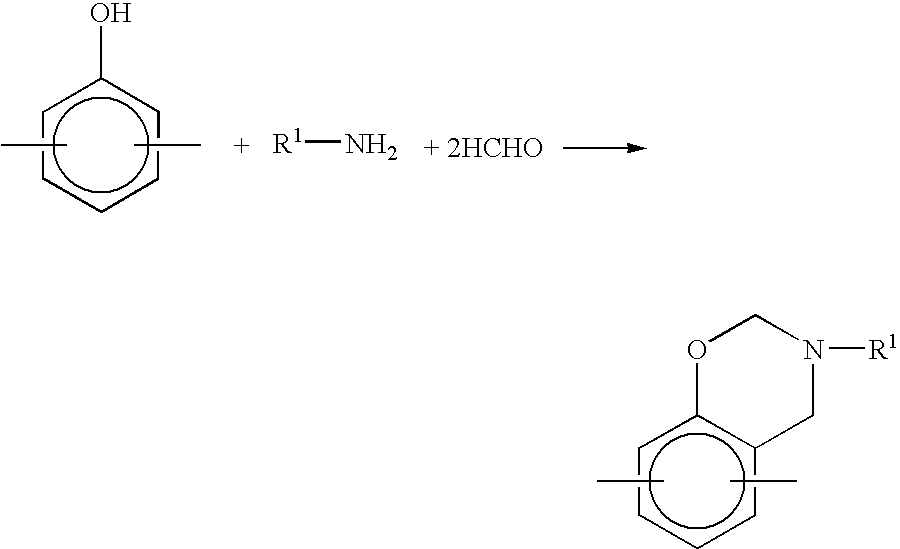Method for producing benzoxazine resin
a technology of benzoxazine and resin, which is applied in the direction of dyeing process, chemical/physical/physical-chemical process, chemical apparatus and process, etc., can solve the problems of requiring enormous efforts to discard and impossible to stir reaction solution
- Summary
- Abstract
- Description
- Claims
- Application Information
AI Technical Summary
Benefits of technology
Problems solved by technology
Method used
Image
Examples
example 1
[0032]Into a 5-liter flask equipped with a thermometer, stirrer, cooling tube and dropping device were charged 1040 g of a phenol-novolac resin having a number average molecular weight (measured by use of a calibration curve of a standard polystyrene in accordance with a gel permeation chromatography method) of 400 and 560 g of methyl ethyl ketone, and the mixture was dissolved by stirring. Then, 600 g of paraformaldehyde was added to the mixture. Under stirring, 931 g of aniline was added dropwise to the mixture over one hour. The temperature of the reaction solution at this time was 81° C. Thereafter, the reaction solution was allowed to react for 7 hours under reflux (80 to 82° C.). Subsequently, the reaction mixture was started to undergo concentration under a reduced degree of the pressure at 360 mmHg under heating. The concentration was continued while keeping this reduced degree of the pressure, and, at the time when the temperature of the reaction mixture reached 110° C., th...
example 2
[0033]Into a 5-liter flask equipped with a thermometer, stirrer, cooling tube and dropping device were charged 1140 g of bisphenol A and 900 g of methyl ethyl ketone, and the mixture was dissolved by stirring. Then, 1622 g of a 37% formalin solution was added to the mixture. Under stirring, 931 g of aniline was added dropwise to the mixture over one hour. The temperature of the reaction solution at this time was 81° C. Thereafter, the reaction solution was allowed to react for 7 hours under reflux (80 to 82° C.). Subsequently, the reaction mixture was started to undergo concentration under a reduced degree of the pressure at 360 mmHg under heating. The concentration was continued while keeping this reduced degree of the pressure, and, at the time when the temperature of the reaction mixture reached 85° C., the reduced degree of the pressure was raised to 90 mmHg. After confirming the absence of effluent (the melting temperature of the resin at this time was 100° C.), the resin was t...
example 3
[0035]Into a 5-liter flask equipped with a thermometer, stirrer, cooling tube and dropping device were charged 1140 g of bisphenol A and 920 g of methanol, and the mixture was dissolved by stirring. To the mixture was added 652 g of paraformaldehyde. Under stirring, 930 g of aniline was added dropwise to the mixture over one hour. The temperature of the reaction solution at this time was 79° C. Thereafter, the reaction solution was allowed to react for 7 hours under reflux (78 to 80° C.). Subsequently, the reaction mixture was started to undergo concentration under a reduced degree of the pressure at 360 mmHg under heating. The concentration was continued while keeping this reduced degree of the pressure, and, at the time when the temperature of the reaction mixture reached 85° C., the reduced degree of the pressure was raised to 90 mmHg. After confirming the absence of effluent (the melting temperature of the resin at this time was 100° C.), the resin was taken out and placed in a ...
PUM
| Property | Measurement | Unit |
|---|---|---|
| pressure | aaaaa | aaaaa |
| temperature | aaaaa | aaaaa |
| azeotropic temperature | aaaaa | aaaaa |
Abstract
Description
Claims
Application Information
 Login to View More
Login to View More - R&D
- Intellectual Property
- Life Sciences
- Materials
- Tech Scout
- Unparalleled Data Quality
- Higher Quality Content
- 60% Fewer Hallucinations
Browse by: Latest US Patents, China's latest patents, Technical Efficacy Thesaurus, Application Domain, Technology Topic, Popular Technical Reports.
© 2025 PatSnap. All rights reserved.Legal|Privacy policy|Modern Slavery Act Transparency Statement|Sitemap|About US| Contact US: help@patsnap.com

